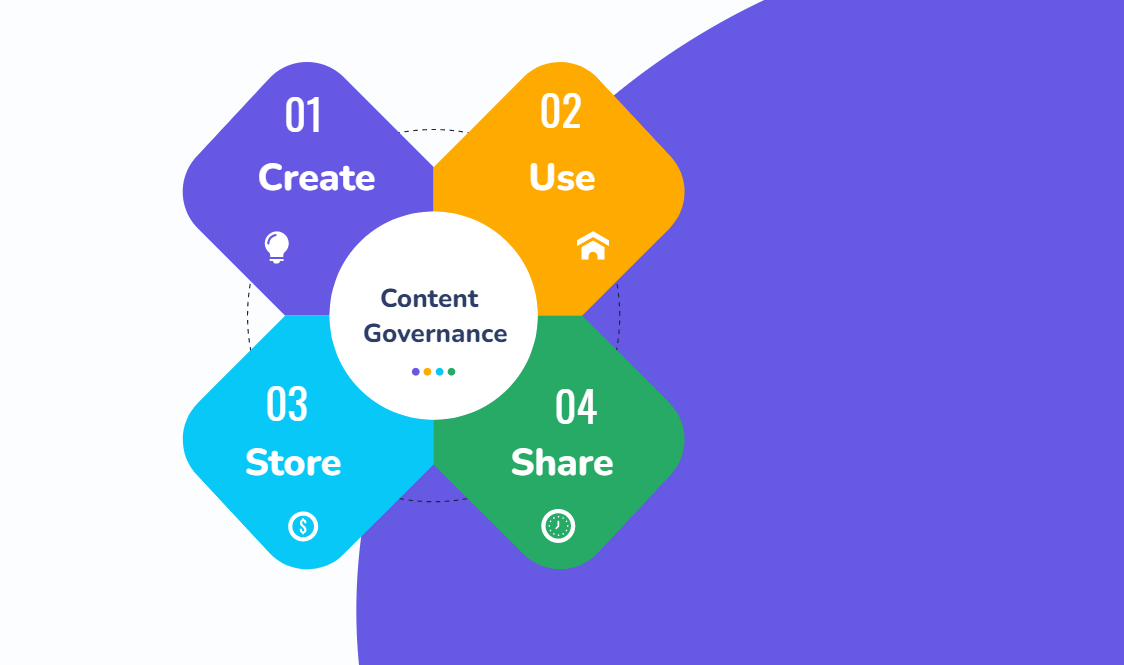Content Governance: Unlock a New Level of Business Growth
If you’re a business owner, you’ve undoubtedly heard the phrases ‘content marketing’ and ‘content strategy’, but what about ‘content governance’? If this phrase is unfamiliar to you, it’s time to get acquainted.
So, in this guide, we’ll explain what content governance is, why it’s important for your business, and how you can achieve it using the right technology.

What Is Content Governance?
Although ‘content governance’ may sound overly corporate and complex, its idea is pretty simple. Let’s explain it.
One of the main challenges organizations face in the digital world is the amount of content they have to produce, manage, and organize. The bigger the company, the more marketing channels it uses, and therefore, the more content it has to deal with. In that scenario, the company likely hires many writers, content creators, social media managers, or content marketplace to keep up with the amount of content it needs.
The truth is that most companies are drowning in content — documents, spreadsheets, presentations, emails, web pages, and more — and they don’t have the strategies or technology in place to manage it properly. As the amount of content grows, so does the need for a reliable system to handle it.
That’s where content governance comes in.
Content governance is a set of guidelines and procedures that dictate how an organization creates, uses, stores, shares, and manages its content over time. It also covers how content is reviewed and approved before it’s published on the web.
Content governance is a practical way to help organizations address content overload. It ensures that the content adheres to specific guidelines, is stored in the right places, and is always up-to-date.

What Happens in the Absence of Content Governance?
Some companies get away with not having a proper content governance strategy in place, but they can only do that until they reach a specific size. When a company gets bigger, it has to deal with a considerable amount of content. In this situation, it can quickly lose control over the content creation and management processes if there are no rules and regulations in place.
Content governance is a necessary component of any content strategy – without it, all the content you create will be scattered in disarray. And even if you have top-notch writers and content creators who produce excellent content, if there’s no process to ensure it gets published correctly on your marketing channels or distributed to the right people within your company, it won’t reach its goal.
In other words, content governance is the boss of your content. It tells everyone in your company who creates, publishes, or otherwise manages your content what to do and how to do it. It makes sure that all of your content is aligned with your brand and business goals. Your content will be chaotic, disorganized, and probably ineffective without it.
Here are some of the problems that arise in the absence of content governance:
1. Lack of Consistency
When many people produce content for a company, everyone must adhere to specific content and brand voice guidelines. If there’s a lack of consistency in your content’s brand messaging and tone of voice, your audience will get confused, and you’ll lose potential customers.
The main goal of content governance is to ensure consistency across all channels where your organization publishes content by creating content rules and guidelines for everyone in the company to follow.
2. Confusion About What Content Needs to be Created
While it’s true that content governance can sometimes lead to overly restrictive rules, it’s more likely that the absence of clear guidelines will result in a situation where no one knows where to start — or who should take on what role.
In addition, producing content without first establishing which pieces are most important can result in an abundance of “nice-to-have” content, such as blog posts on topics of interest only to the author, at the expense of “must-have” content that supports the company’s goals.
3. Content Unaligned with the Company’s Goals
Content governance isn’t just about managing the content published on the web. It’s also about ensuring that content serves the company’s overall mission. This can involve coordinating with various departments to ensure that the content produced across the organization is aligned with the company’s goals.
4. Duplicate Content
The absence of content governance can lead to the creation of duplicate content. For example, a newly hired social media manager may post duplicate content without realizing it’s been published before. This will result in a negative impact on the business.
Why Organizations are Looking for Content Governance Solutions?
Many companies have already realized that they need to implement content governance to manage their content more efficiently and reduce costs associated with creating, storing, and distributing it.
We’ve asked our experts in areas of management, marketing, and content at Desygner for their opinions on why content governance should be a priority for organizations.
Alex Rich, Chief Executive Officer and Founder (CEO)
“Desygner enforces governance knowing that any textual or image change is proliferated across the organization in all published documents via a fully integrated asset, design, and dissemination solution.”

Mariana Aguiar, Chief Marketing Officer (CMO)
“Smart managers have realized that the time their team could be focusing on the bigger picture is instead spent on focusing on finding files and replacing content that is out-of-date. Another common stress is publishing content that is not in accordance with brand guidelines. If you save that brainpower and put it into innovation then you have an amazing solution. So instead of focusing on what is wrong with your content, you’re focusing more on what your content needs to do.”

Cidonie Richards, Head of Marketing and Communications
“As a content strategist and manager of writers around the world, I understand how quickly content can become off-brand and disorganized quickly without a reliable system in place. We now live in a world where everyone has become content creators and providers, but to govern content effectively, organizations need to embrace the correct technology.”

Technological Solutions to Achieve Content Governance Within the Organization
Content governance is crucial for any brand to achieve consistency in voice, style, and tone. However, many organizations struggle with maintaining content governance due to the lack of resources available.
The good news is that many technological solutions are available to alleviate this problem. These include solutions such as CMS platforms and brand-approved digital asset libraries, which are necessary to manage content successfully.
Due to limits in budget and resources, many brands are looking for a cost-effective, easy-to-integrate technological solution to implement their content governance processes. This is where Desygner comes in!
Desygner is a one-stop shop for brands to create marketing materials for their business and manage content across their organization. Thanks to our features and tools, you can:

1. Create and Store Content
Thanks to our DAM (Digital Asset Management) software, brands can design and store their own templates and assets in one place. In addition, our portal allows users to create multiple workspaces to manage their clients, departments, or teams within Desygner.
2. Control What Users Can and Cannot Change
With our Brand Guidelines Enforcer, you can decide exactly how each of your branding elements, designs, and templates can be modified. You can choose what other team members can and cannot add or change, so they can only modify what you want them to.
3. Distribute Digital Content to Different Groups
Desygner’s portal allows companies to create collections of branded materials available to different groups of users at different times. So, it helps you keep things simple and organized when distributing branded materials to other people within the organization.
4. Approve Workflows
Desygner’s approval flow allows administrators to approve designs and review other people’s work before it goes out the door. What’s more, our task manager enables creatives to manage tasks within our system and allows non-creative team members to ask for help when they’re stuck on a project.
Grow Your Business with Content Governance
At its most basic level, content governance is all about keeping all of your content organized and clean. But there’s a lot more to it than that. With structured, organized content, you’ll be able to ensure that all the content produced in your organization is of high quality and up to your company’s standard.
And, who knows? Perhaps you’ll even unlock a new level of business growth that you haven’t thought possible! So give it a go, and see how implementing content governance can transform your business. At Desygner, we’re rooting for you. Get in touch with us to see how we can help you.






